How to back up iPhone to Mac: Top methods and tools
▼ TL;DR: How to back up an iPhone to Mac
- Use Finder to back up your iPhone (macOS Catalina and later, including Sequoia).
Connect iPhone > Open Finder > Click iPhone under Locations > General > Back up all data to this Mac > Back Up Now. - Back up with iTunes (macOS Mojave and earlier).
Connect iPhone > Open iTunes > Click Device icon > Summary > Back Up Now. - Use AnyTrans for iOS for quick, selective backups.
Want to back up specific content like photos, messages, or music? Use AnyTrans for iOS (available on Setapp). AnyTrans also supports media downloads, scheduled backups, and file syncing. - Back up your iPhone wirelessly over Wi-Fi.
Once connected via USB at least once, you can back up wirelessly: Finder > Click iPhone > General > Check “Show this iPhone when on Wi-Fi” > Apply. Now your iPhone will appear in Finder when on the same Wi-Fi network. - Use iCloud for remote, automatic backups.
Go to iPhone Settings > Apple Account > iCloud > iCloud Backup > Toggle on > Back Up Now. Note: Only 5 GB is free. - Keep your data safe with iBoysoft Data Recovery
Before resetting or updating your device, protect your data with iBoysoft Data Recovery. It helps recover lost iPhone backups, deleted files, and corrupted data from drives - Get even more control over your backups with Setapp.
Setapp gives you access to AnyTrans for iOS, Get Backup Pro, CloudMounter, iBoysoft Data Recovery, and 250+ more apps in one subscription. Try it free for 7 days and simplify your iPhone backups, file transfers, storage management, and more.
Our smartphones hold a lot of meaningful data (virtually our whole lives!), making us powerful yet vulnerable to the possibility of losing it all. There’s a way to prevent such a catastrophe, and that’s to regularly back up iPhones to computer.
In this guide, I'll give you 6 simple answers to your question: "How do I back up my iPhone to my Mac computer?"
Case | Solution | Steps |
Need a quick and easy backup solution | Use AnyTrans for iOS | Open AnyTrans for iOS on Mac > Connect iPhone with a USB cable > Device Manager > Content to Mac. |
No iTunes on macOS Catalina and later | Use Finder for backups | Connect iPhone to Mac with a USB cable > Open Finder > Click your device (Locations) > General > Back up all data on this iPhone to this Mac > Back Up Now. |
Using macOS Mojave or earlier | Use iTunes for backups | Connect iPhone to Mac with a USB cable > Open iTunes > Select your iPhone > Back Up Now. |
Need to recover backup files | Use iBoysoft Data Recovery | Open iBoysoft Data Recovery > Search for Lost Data > Recover. |
Backup without a cable | Enable Wi-Fi syncing | Open Finder > choose iPhone > General > Options > Show this iPhone when on Wi-Fi > Apply. |
Wireless backup via iCloud | Use iCloud Backup | Open Settings on iPhone > Apple ID > iCloud > iCloud Backup > Back Up Now. |
Want to get quick solutions? You can get personalized step-by-step guidance for iPhone backups and troubleshooting from the iPhone Help Assistant on ChatGPT.
Where are iPhone backups stored on Mac?
Before we get into the details of how to back up iPhone to Mac, here's a little rundown of where to find your previous backups if you want to move them around or delete them to make space on your local drive:
- Select Go ➙ Go to Folder… in the menu bar
- Type the following path: ~/Library/Application Support/MobileSync/Backup/
- Press Return and look for a Backup folder
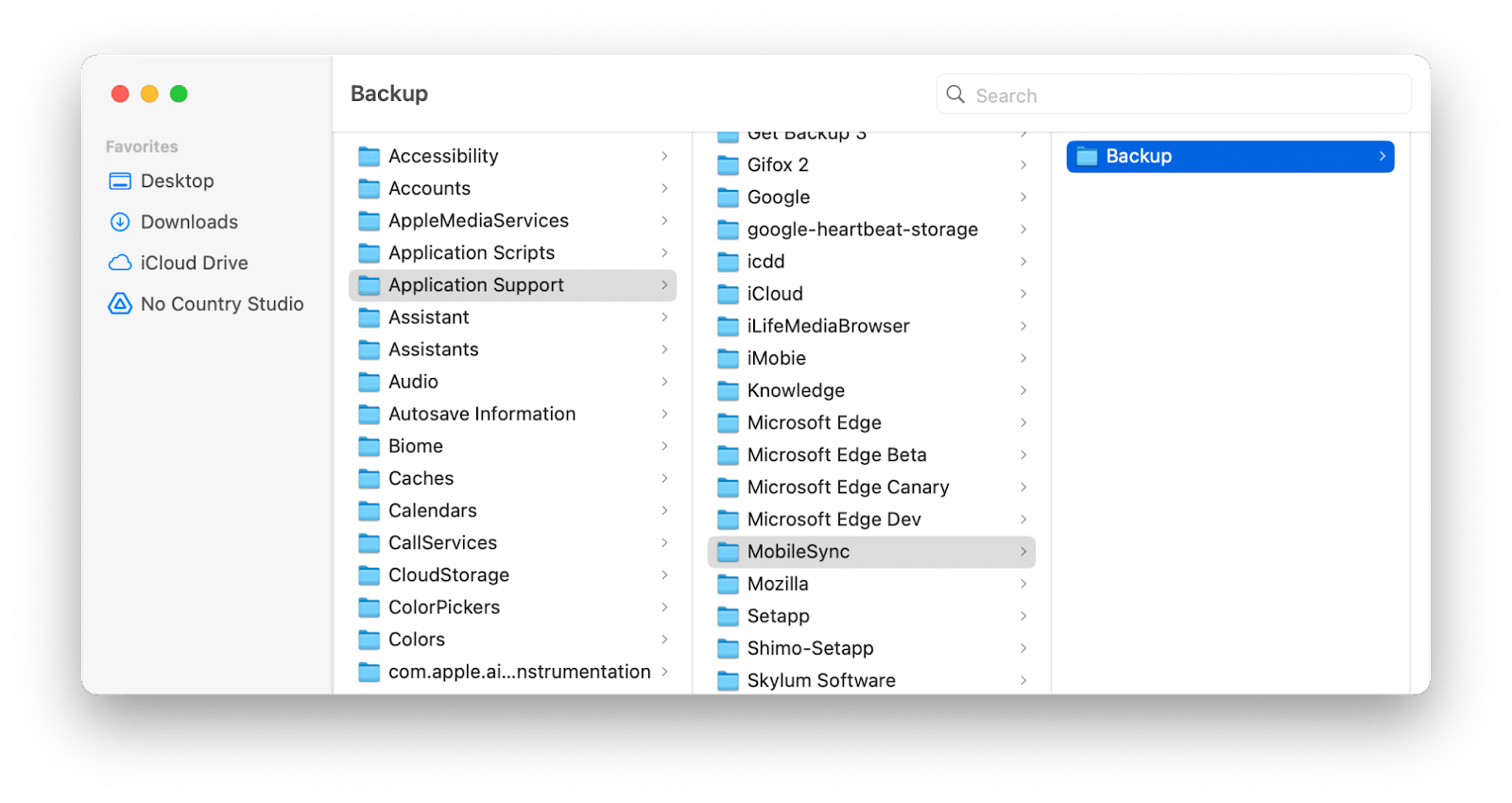
The easiest way to back up your iPhone to Mac
Let’s begin with the quickest solution: using a professional file manager like AnyTrans (that's how I backup my iPhone to my computer).
Considered a smart alternative to Apple’s iTunes, AnyTrans is a more flexible backup solution with a range of features to bring your devices into sync. Connect your iPhone and watch its contents fly with AnyTrans as it instantly backups and copies your iPhone content to Mac or transfers data across iOS. Enjoy seamless data migration, secure management of backups, and easy scheduling, plus quick media downloads from more than 900 sites — all at your fingertips.
Here’s how to backup iPhone to computer with AnyTrans:
- Open AnyTrans on your Mac
- Connect your iPhone to the computer with a USB cable
- Click Device Manager in the top left corner
- Select Content to Mac
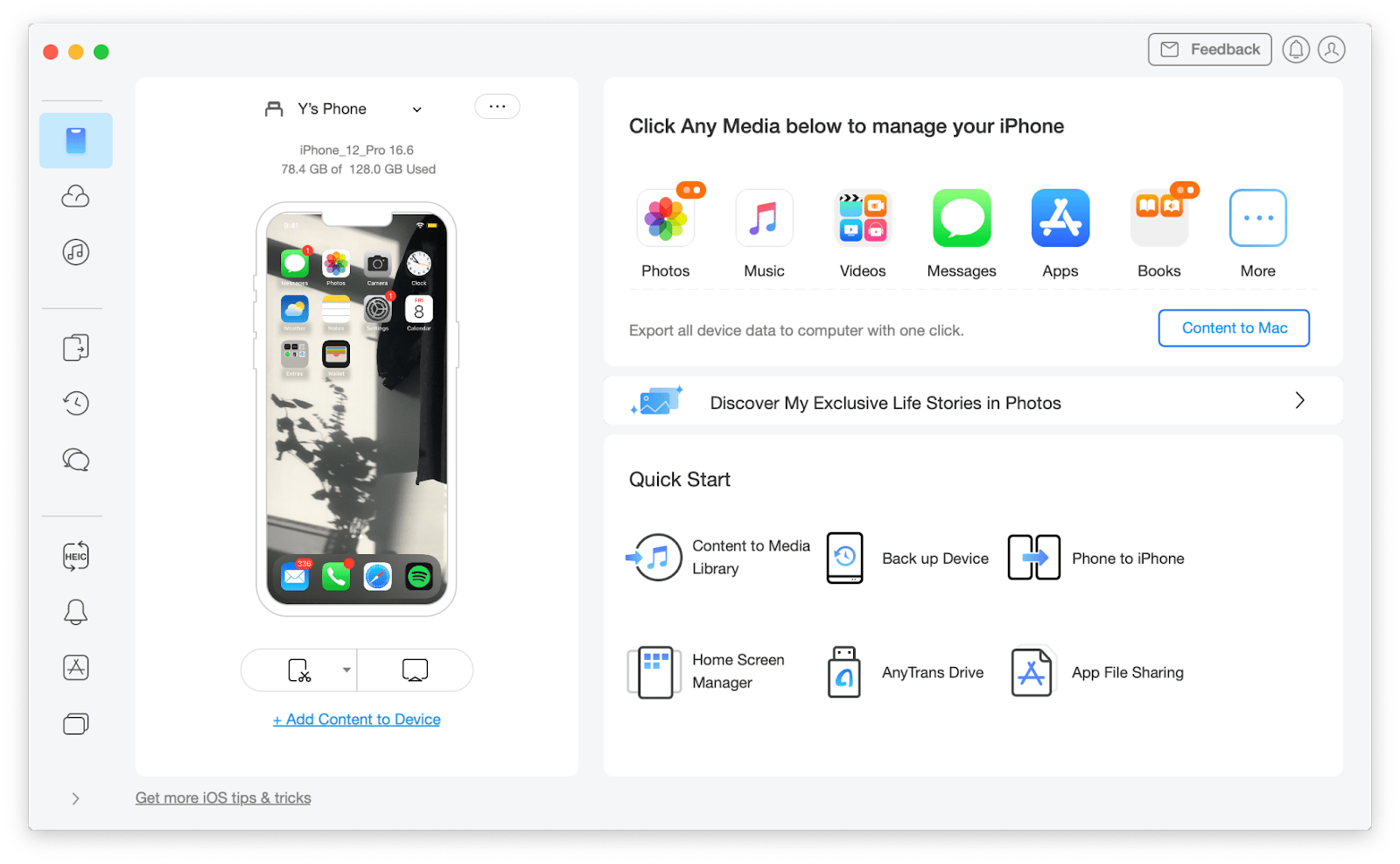
How to backup your iPhone to Mac using Finder
Finder is Apple’s native data manager responsible for launching other apps and for the overall user management of files, disks, and network volumes. It’s also the right utility to use when you want to back up iPhone to computer.
If this is the first time you’ll be connecting your Mac and iPhone through a cable, you’ll be asked to pair the two on the Mac, and trust the Mac on your iPhone.
Here’s how to back up my iPhone to my computer through Finder:
- Connect your iPhone to your Mac using a cable.
- Open Finder.
- Click on your device under Locations in the left column.
- Select General and look for the Backups section.
- Click Back Up Now.
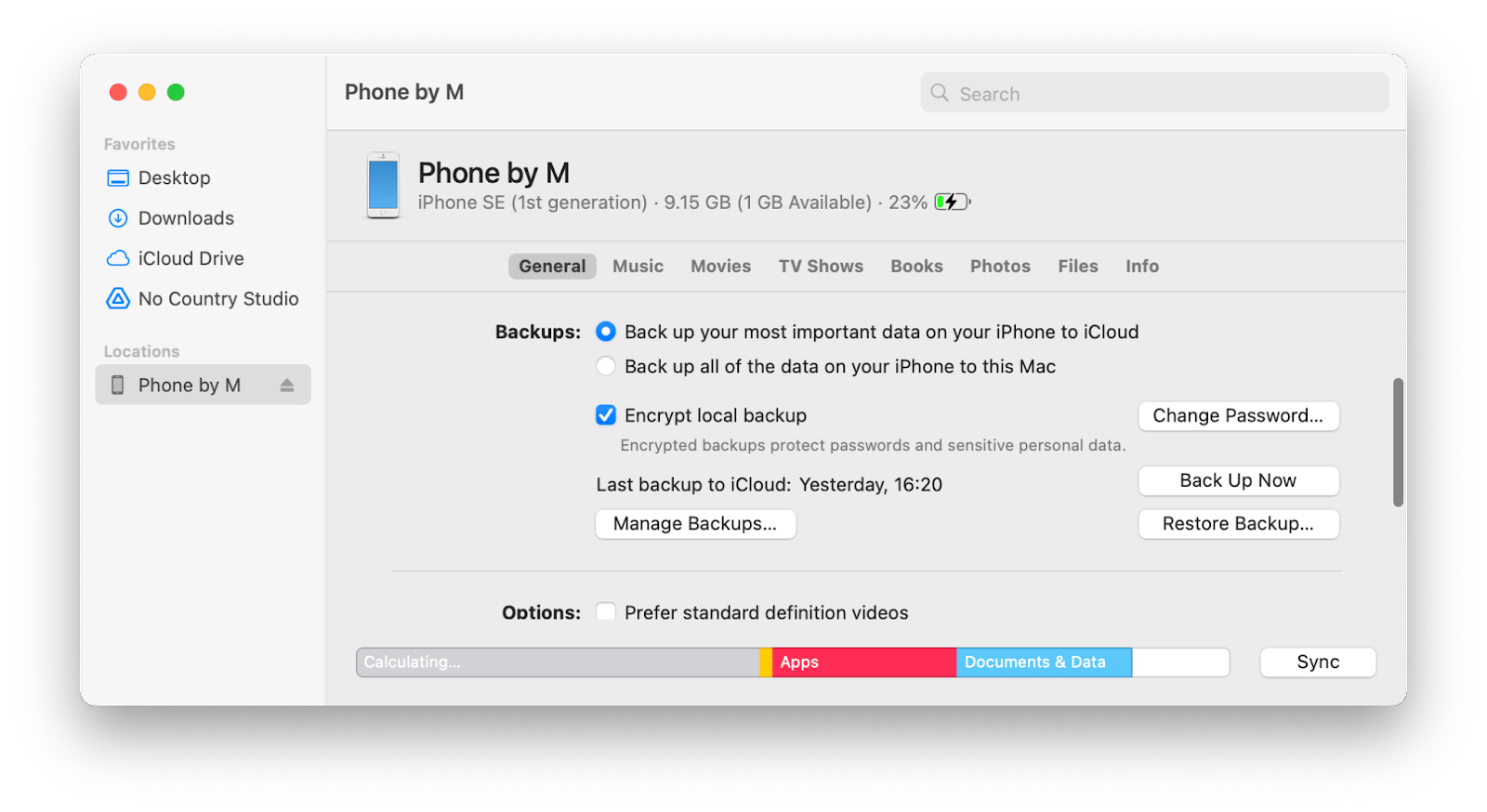
If you want to encrypt the backups on your Mac, you can check the “Encrypt local backup” box before clicking “Back Up Now” and create a password.
Once you start interacting more with your Mac, you may notice that Finder isn’t enough for all your needs. That’s a perfect time to try Path Finder.
Path Finder is an advanced file manager based on a unique modular system with a list of customizable features you can add and remove from the interface at any time. Copy, delete, view, and sync heaps of files across different locations in a matter of seconds.
Path Finder has a handy housekeeping feature — a Drop Stack for temporary storing. Simply select a batch of files and move them to a grid on the side of the app’s window before moving them anywhere else.
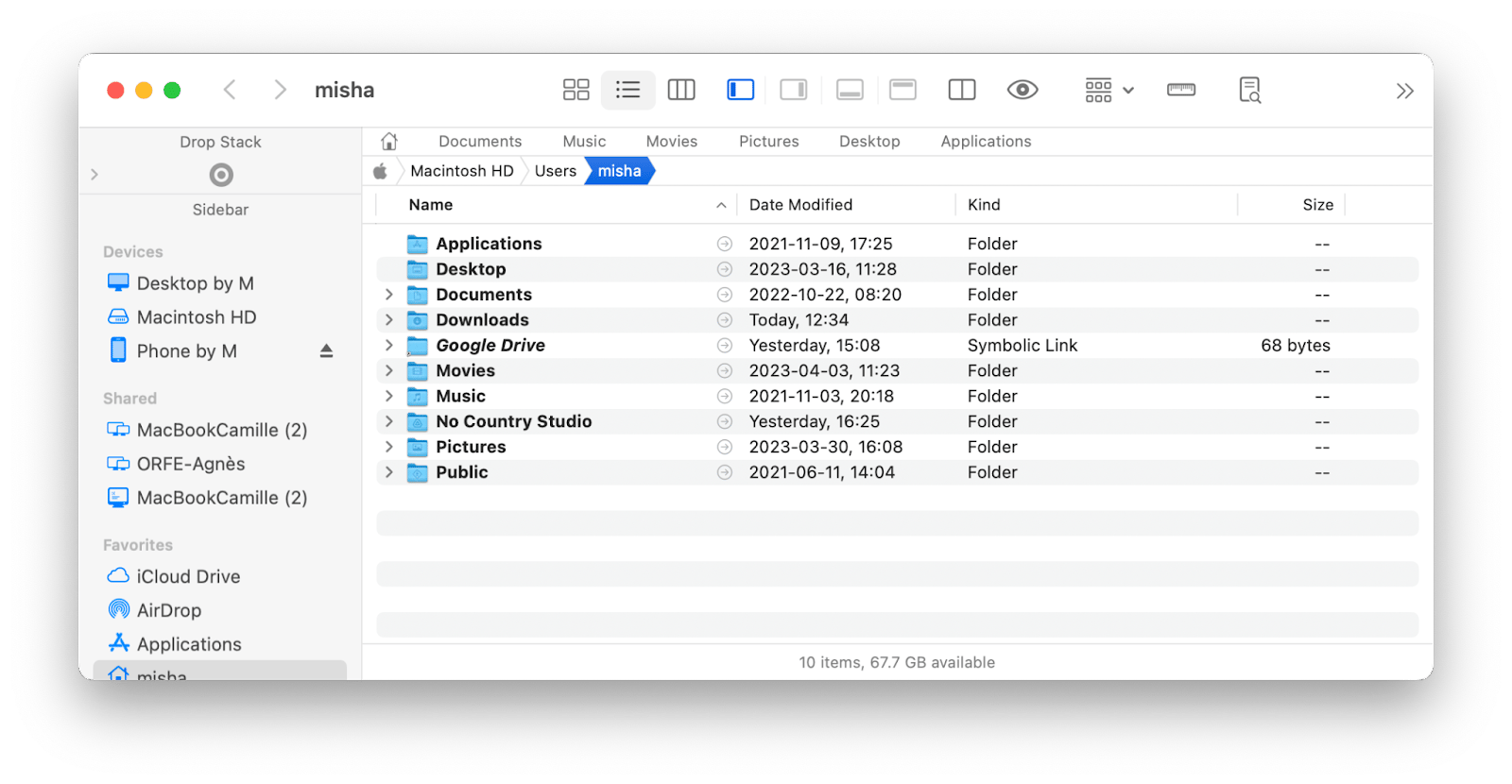
How to restore your iOS device backups on Mac
Once you know how to back up iPhone on Mac through Finder, you might soon need to restore that iOS backup. Here’s how:
- Connect your iPhone to your Mac using a cable.
- Open Finder.
- Click on your device under Locations in the left column.
- Select General and look for the Backups section.
- Click Restore Backup.
- Select the backup you want to restore from the drop-down list.
- Enter your password and click Restore.
If this option fails because of corruption or missing files, you can try to save your backup using iBoysoft Data Recovery
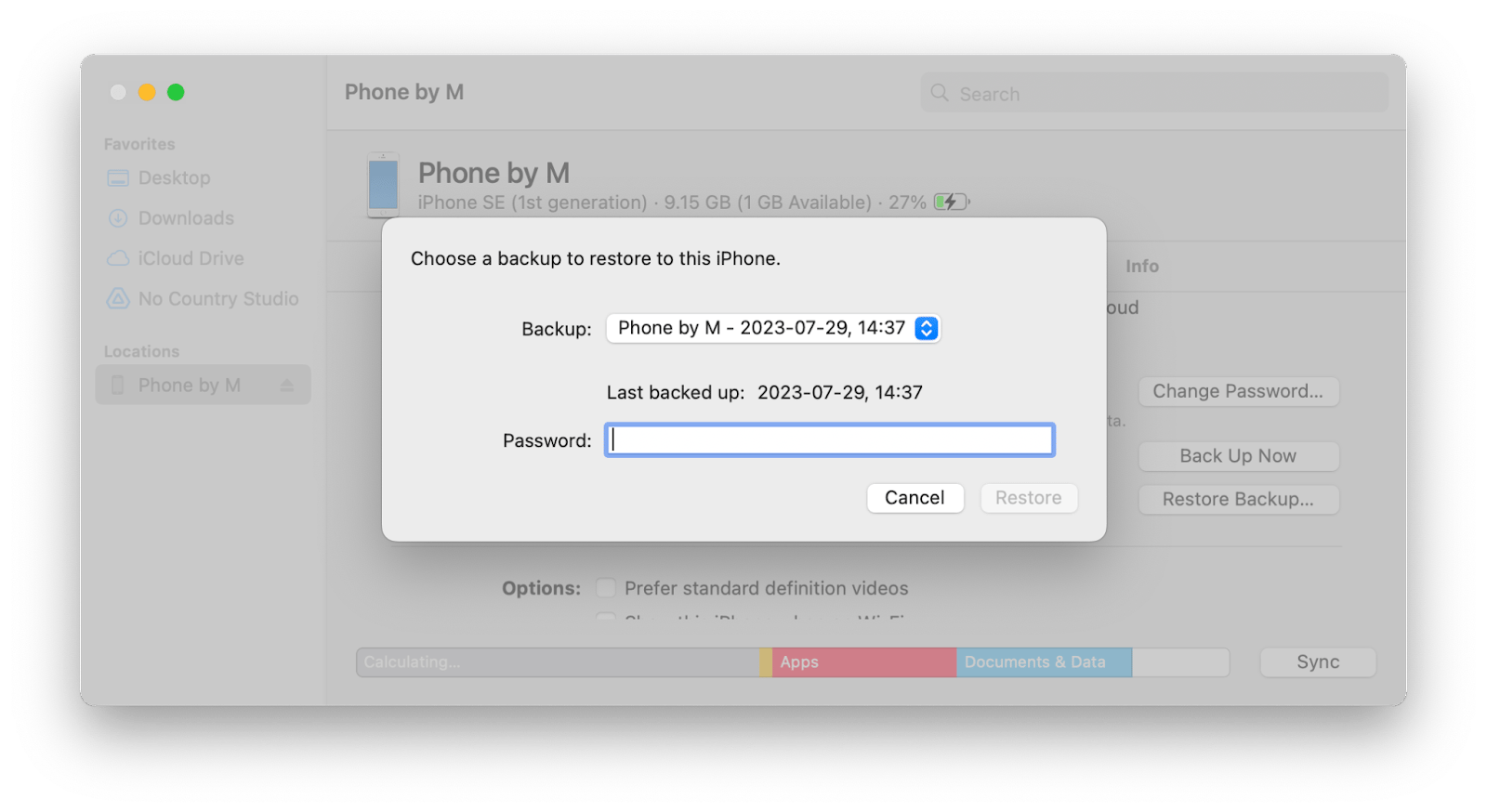
Alternatively, you can use Get Backup Pro for a quicker and smoother process of backing up your devices and restoring those backups.
Get Backup Pro is a reliable utility that can help you save space on your Mac by backing up only essential files. You can choose different kinds of backups, like cloning or synchronization, plus automate the process by setting up scheduled backups of your most necessary data. And once you’re ready to restore, Get Backup Pro lets you transfer all your information to any device without having to install the app there too!
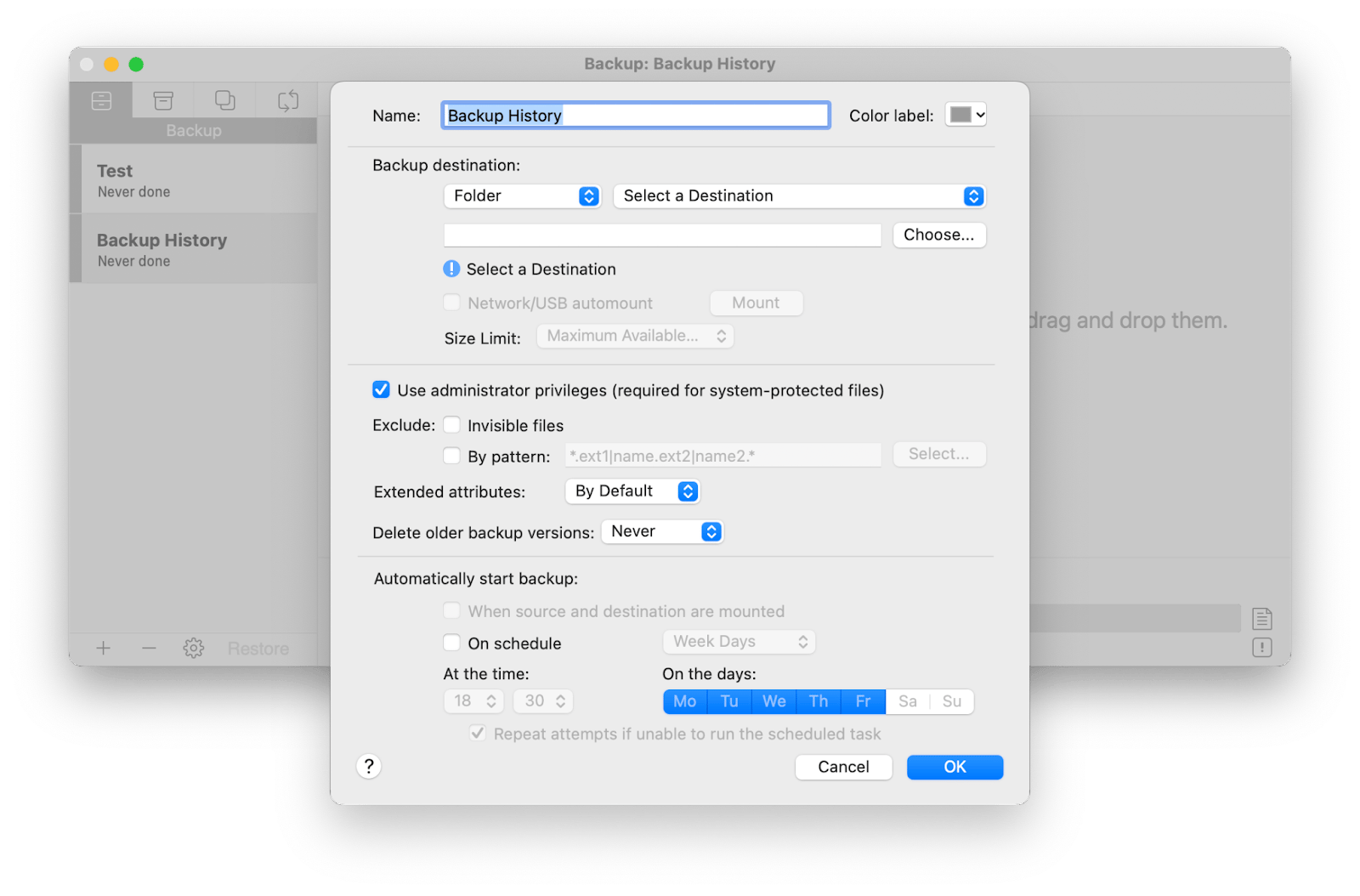
How to back up your iPhone to Mac via iTunes
Starting with macOS Catalina, released in 2019, Apple split the iTunes app into three: Music, TV, and Podcasts. Since iTunes continues to be available on Macs running macOS Mojave or earlier, here's how to backup iPhone on Mac using this old but very convenient app:
- Connect your iPhone to your Mac with a USB cable.
- Open iTunes.
- Type in your device password or choose to trust this computer, if prompted.
- Select your iOS device on your Mac.
- Click Back Up Now.
Using a cable to connect your iOS devices to your Mac isn’t the only option for how to backbup iPhone on computer. While your devices are connected, you can enable Wi-Fi syncing to eliminate the need for future wired connections between the two devices. Here’s how:
- Open Finder and choose your iPhone.
- Click General and scroll down to Options.
- Select Show this iPhone when on Wi-Fi.
- Click Apply.
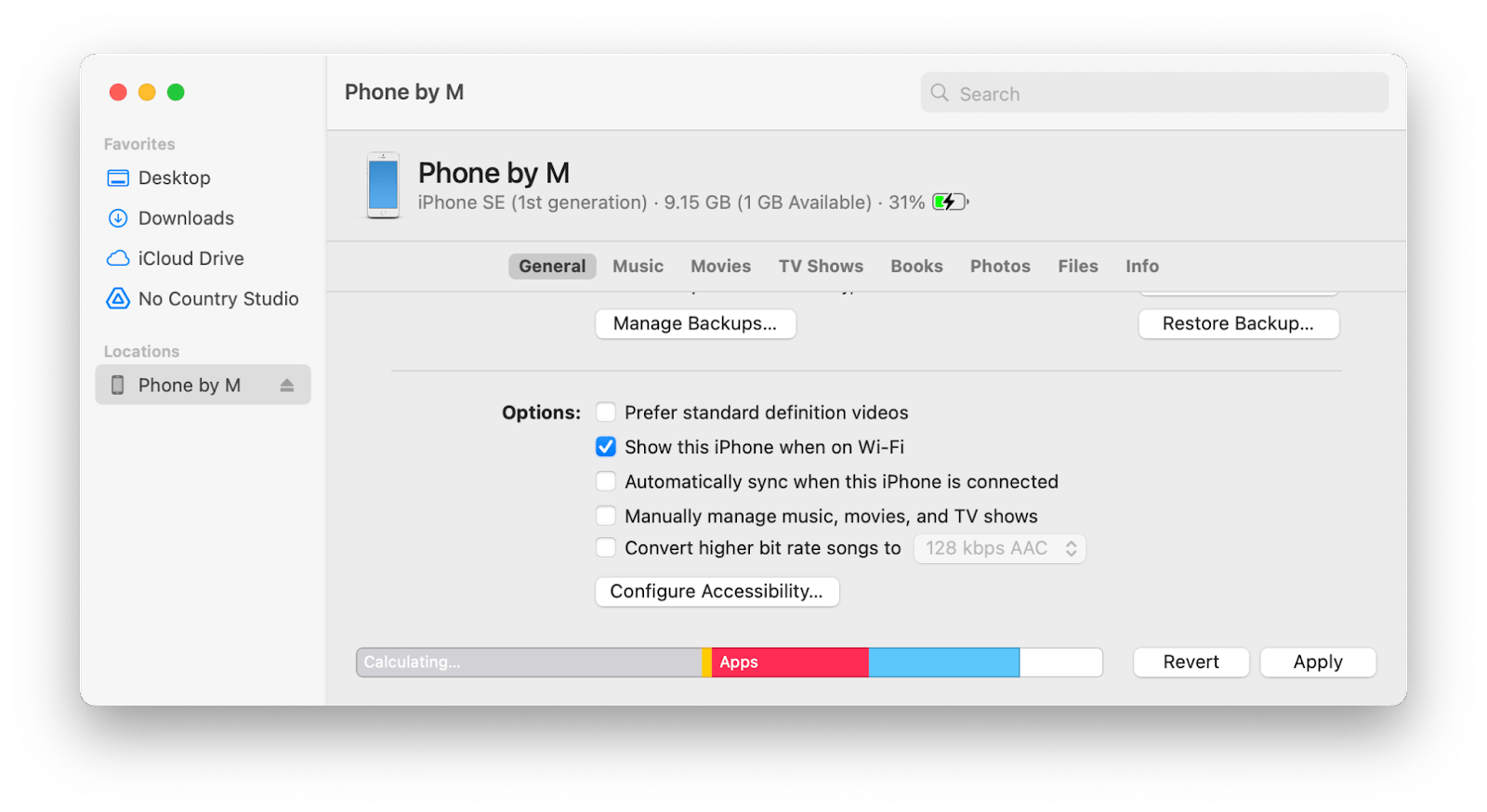
Now, you should be able to view and back up your iPhone through the Finder app on your Mac when both devices are connected to the same WiFi network.
How to back up iPhone to iCloud on Mac
Another wireless solution is backing up your iPhone with iCloud. This way, all your backups will be saved in the cloud, not your Mac, and you’ll be able to access your data from anywhere with Wi-Fi as long as you remember your Apple ID and password. You don’t need to plug your device into your Mac to backup using iCloud, just follow these steps:
- Open Settings on your iPhone
- Tap your Apple ID profile at the top
- Choose iCloud and tap iCloud Backup
- Select Back Up Now
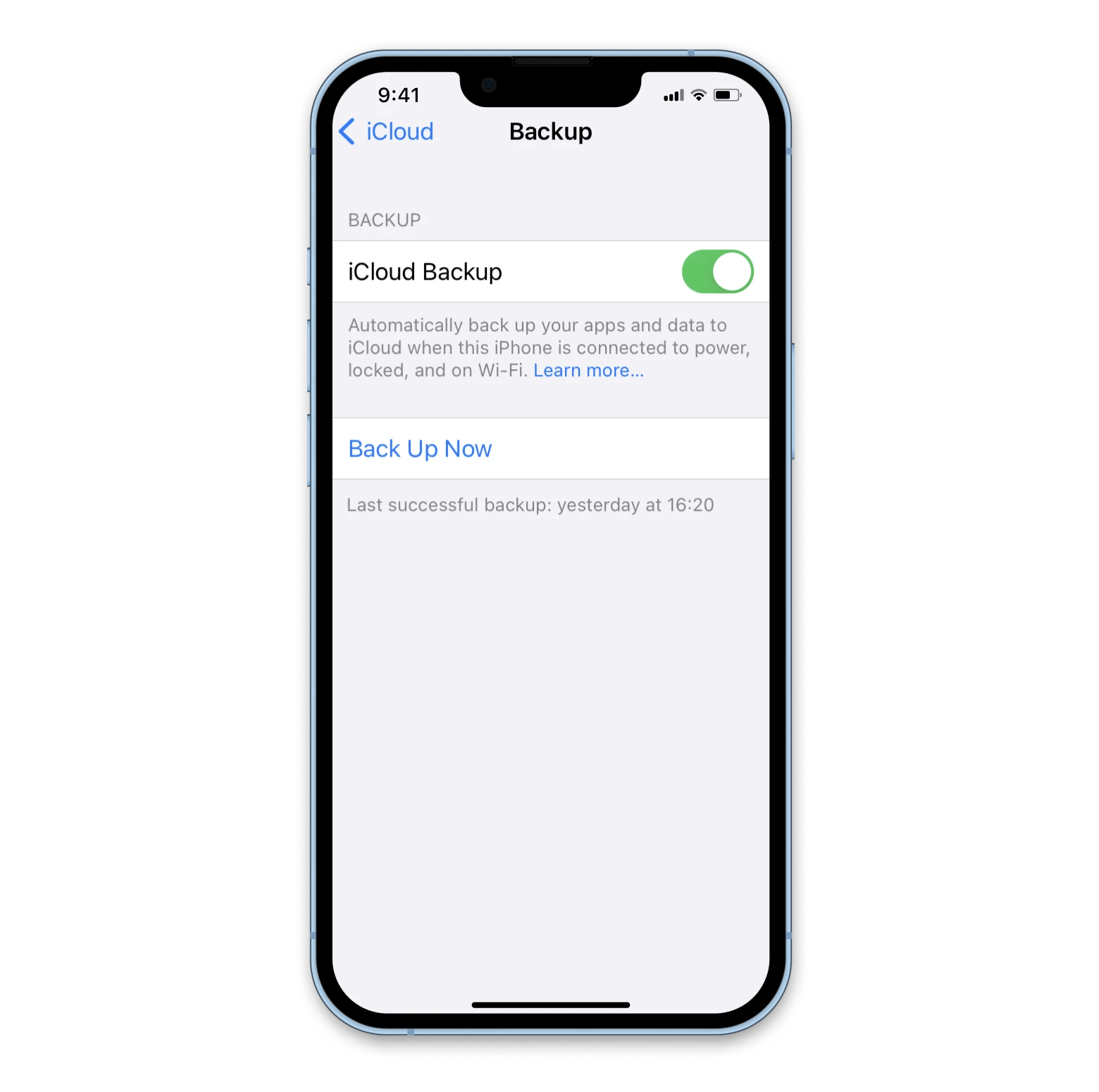
Keep in mind that iCloud only offers 5 GB of free storage space, and you’ll need to pay if you need more. An additional drawback of this method is that iCloud backups don’t include your music or any other audio or video content.
Try apps for backing up your iPhone to Mac for free
Routine backups of your iPhone are quite important, especially if you’re planning to move all data stored on one device elsewhere in the future. Backups are also very simple if you have the right apps to help you with this process.
AnyTrans is just the quickest way to back up an iPhone to a computer, while Get Backup Pro and CloudMounter offer stable backups and easy access to unlimited cloud storage. Plus, Path Finder will expand your Mac’s Finder’s possibilities, WiFi Explorer will fix any and all of your connection problems to ensure smooth backups, and iBoysoft Data Recovery will restore all your lost backups!
Try all of these apps — Get Backup Pro, CloudMounter, Path Finder, and WiFi Explorer through Setapp's platform, which gives you one-stop access to more than 250 utilities for any use case you can imagine. Best of all, Setapp has a seven-day free trial to let you experiment with all its tools at no cost!
FAQs: How to backup iPhone to Mac
In addition to the above methods for how to backup iPhone on computer, here are some answers to the most common questions about this case.
Why can’t I back up my iPhone to my Mac?
There can be a few reasons for this, ranging from a faulty USB cable or USB port on your Mac, to software problems, your Mac freezing, or you simply forgetting to unlock your iPhone and click Trust on your Mac to back up an iOS device.
How long does it take to back up an iPhone to Mac?
Usually, it can take anywhere from 20 minutes to two hours to fully back up an iPhone, but the total backup time depends on the amount of data stored on your iPhone, its model, and the iOS version it’s running.
Does backing up an iPhone to Mac save photos?
A computer backup of your iOS device includes almost all of your device’s settings and data, including photos from the camera roll. If you have iCloud Photo Library enabled, all your photos will be automatically backed up to iCloud as well.
Why can't I back up my iPhone to my Mac?
There could be several reasons for this problem.
- First, make sure your Mac is running macOS Catalina or later for Finder backups, or macOS Mojave or earlier for iTunes. Both your macOS and iPhone should be updated to the latest software versions.
- Check your USB connection and try using a different cable or port.
- Make sure your Mac has enough free space to complete the backup, and that you have trusted your Mac to your iPhone by tapping Trust at the prompt.
- If you're trying to back up wirelessly, make sure both devices are on the same Wi-Fi network and that Wi-Fi sync is turned on.
- Close any other apps that may be interfering with the backup process and restart both devices.
If the problem persists, consider using a dedicated backup tool like AnyTrans for more flexibility and reliability.
Can I back up my iPhone to an external hard drive or SSD on Mac?
Yes, you can back up your iPhone to an external drive or SSD by creating a symbolic link (symlink) that points to the external drive. If you want to avoid the technical steps and get more flexibility, you can perform the backup using Get Backup Pro. It’s a reliable tool that automates the backup process for you.
Do iPhone backups include apps and app data?
Your iPhone backups include most of the app data, but not the apps themselves. After the restoration, the phone will download your apps from the store and then apply your settings and app data. This way, everything will look and work just the way you left it.
What’s the difference between iCloud backup and Mac backup?
The difference between iCloud backup and Mac backup is where the data is stored. iCloud backups are stored on your Apple account cloud space, so they live online. The backups usually happen automatically at night when your iPhone is charging and on Wi-Fi. Mac backups are more manual. They happen when you connect your iPhone to your Mac and are saved on your Mac. Both methods keep your data safe, so it depends on whether you want the convenience of automatic backups or the control and flexibility of Mac backups.
How do I check if my iPhone backup on Mac is encrypted?
You can check if your iPhone backup on Mac is encrypted using Finder, and here's how:
Connect your iPhone via a USB cable.
Open Finder.
Click on your iPhone from the sidebar.
Check for a tick next to Encrypt local backup.
It's always good to encrypt your backups for maximum privacy and data security.





